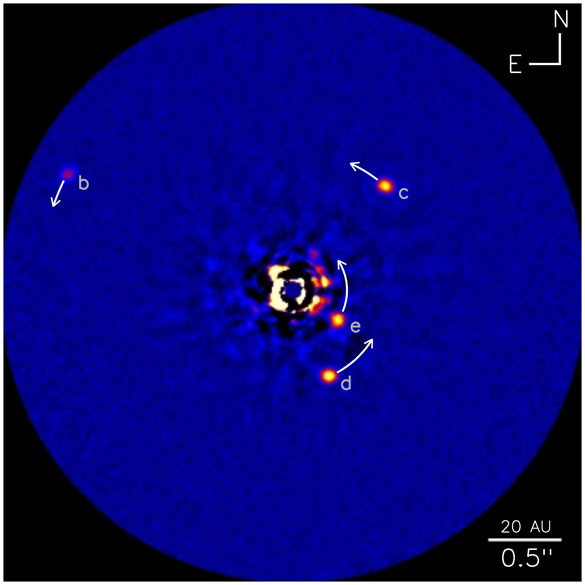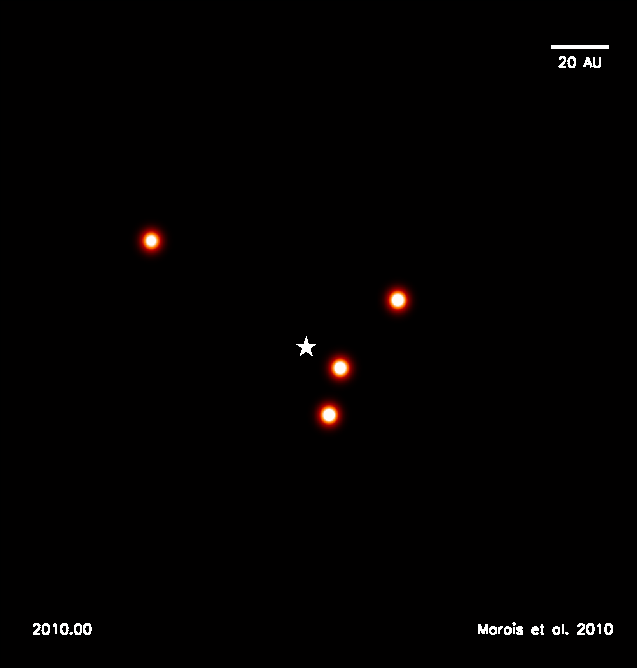Our four giant planets are Jupiter, Saturn, Uranus and Neptune. Like our solar system, HR 8799 also contains two 'debris belts' composed of small rocky or icy objects, along with lots of tiny dust particles, ours being the asteroid belt between the orbits of Mars and Jupiter and the Kuiper Belt, beyond Neptune's orbit.
The mass of the HR 8799 planetary system is much greater than our own and astronomers estimate that the combined mass of just the four giant planets may be 20 times greater than the mass of all the planets in our solar system, and the debris belt counterparts also contain much more mass than our own.
The new planet joins three previously discovered planets that were the subjects of a 2008 paper in Science reporting the first-ever images of a planetary family orbiting a star other than our sun.

An image of HR 8799e obtained at the Keck II telescope, refined using NRC’s adaptive optics system, showing all four confirmed planets. Arrows illustrate possible planet orbital motions for the next ten years. Credit: NRC-HIA, C. Marois&Keck Observatory
All four planets orbiting HR 8799 are similar in size, likely between five and seven times the mass of Jupiter. The newly discovered planet orbits HR 8799 more closely than the other three. If it were in orbit around our sun, astronomers say, it would lie between the orbits of Saturn and Uranus.
The astronomers used the Keck II telescope at Hawaii's W.M. Keck Observatory to obtain images of the fourth planet.
"We reached a milestone in the search for other worlds in 2008 with the discovery of the HR 8799 planetary system," said Christian Marois, an NRC astronomer and lead author of the Nature paper. "The images of this new inner planet are the culmination of 10 years' worth of innovation, making steady progress to optimize every aspect of observation and analysis. This allows us to detect planets located ever closer to their stars and ever further from our own solar system."

An animation demonstrating plausible orbits of the HR 8799 planets through one complete period (~465 years) of HR 8799b, the outermost planet. For each orbit of HR 8799b, HR 8799c and HR 8799d will orbit twice, and HR 8799e will orbit four times. Credit: LLNL&Q. M. Konopacky
"The four massive planets pull on each other gravitationally," said co-author Quinn Konopacky, a postdoctoral researcher at LLNL. "We don't yet know if the system will last for billions of years or fall apart in a few million more. As astronomers carefully follow the HR 8799 planets during the coming decades, the question of the stability of their orbits could become much clearer."
The origin of these four giant planets remains a puzzle; neither of the two main models of planet formation can account for all four.
"There's no simple model that can form all four planets at their current location," said co-author Bruce Macintosh of LLNL. "It's going to be a challenge for our theoretical colleagues."
It is entirely plausible that this planetary system contains additional planets closer to the star than these four planets, quite possibly rocky, Earth-like planets, said Benjamin Zuckerman, a UCLA professor of physics and astronomy and co-author. But such interior planets are far more difficult to detect, he added.
"Images like these bring the exoplanet field, which studies planets outside our solar system, into an era of exoplanet characterization," said co-author Travis Barman, a Lowell Observatory exoplanet theorist. "Astronomers can now directly examine the atmospheric properties of four giant exoplanets that are all the same young age and that formed from the same building materials."
Detailed study of the properties of HR 8799e will be challenging due to the planet's relative faintness and its proximity to its star. To overcome those limitations, Macintosh is leading an effort to build an advanced exoplanet imager, called the Gemini Planet Imager, for the Gemini Observatory. This new instrument will physically block the starlight and allow quick detection and detailed characterization of planets similar to HR 8799e. UCLA and the NRC are also contributing to Gemini Planet Imager.
James Larkin, a UCLA professor of physics and astronomy, is building a major component of the imager, which is scheduled to arrive at the Gemini South Telescope in Chile late next year.
Citation: Christian Marois, B. Zuckerman, Quinn M. Konopacky, Bruce Macintosh&Travis Barman, 'Images of a fourth planet orbiting HR 8799', Nature (2010) doi:10.1038/nature09684





Comments